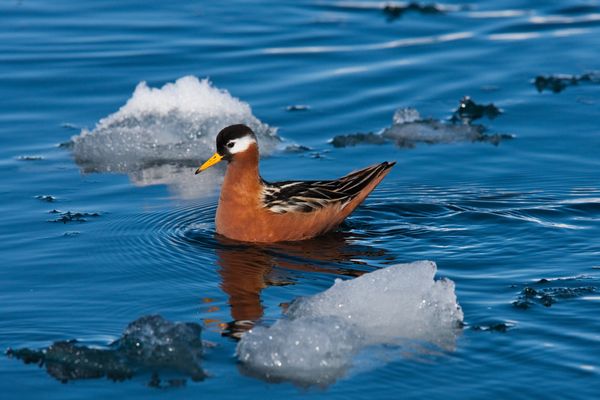For Some Arctic Birds, Time of Day Is Irrelevant
A red phalarope paddles between chunks of ice in the Arctic.
Arctic summers mean migrating animals, a bounty of breeding opportunities, and 24 hours of sunlight. Many plants and animals experience 24-hour cycles telling them when it's time to rest and when it's time to get up—called the circadian rhythm—that are often tied to light cues. So what happens when the sun never sets?
For four species of migrating birds that breed in the Arctic, new research shows that "anything goes," said Bart Kempenaers, a behavioral ecologist with the Max Planck Institute for Ornithology near Munich.
Lapland longspurs (Calcarius lapponicus) exhibit a 24-hour cycle, while semipalmated sandpipers (Calidris pusilla) and pectoral sandpipers (Calidris melanotos) are active around the clock. Red phalaropes (Phalaropus fulicarius) shift from a roughly 21-hour cycle to a 29-hour cycle.
The type of cycle each displays depends on the species, an individual's sex, and their social circumstances.
Arctic residents like the reindeer and a bird called the ptarmigan don't really have a 24-hour cycle, said Kempenaers, co-author of a recent study published this week in the journal Proceedings of the Royal Society B.
Scientists think this enables the permanent residents to take advantage of the midnight sun to feed around the clock. (Read about Scandinavians who walk with reindeer in National Geographic magazine.)
But Kempenaers and colleagues were curious to see what happened with Arctic migrants.
So the scientists studied the activity patterns of four bird species that migrated to the same area near Barrow, Alaska (map) to reproduce during the Arctic's five-week breeding season. (See pictures of other Arctic animals.)
They attached 0.03-ounce (one-gram) radio transmitters to 142 individuals of Lapland longspurs, semipalmated sandpipers, pectoral sandpipers, and red phalaropes.
The radio tags allowed researchers to continuously monitor individual activity levels, which the team then verified with behavioral observations in the field.
Synching Cycles
Kempenaers and colleagues found that semipalmated sandpipers—a one-ounce (30-gram) bird, where both parents incubate the eggs—exhibited a "free-running" cycle. Mated pairs still showed activity patterns, but they ranged from a 21- to a 29-hour cycle.
In 6 of the 11 pairs researchers studied, the birds shifted their cycles from shorter to longer hours over the course of the incubation period.
Pairs differed with respect to how long their cycles lasted, but birds within a pair were always on the same cycle.
"It's incredible—a really unique finding," said Noah Ashley, an ornithologist at Western Kentucky University in Bowling Green who was not involved in the research.
"There's a social synchronization of that activity cycle," he said. "That's what's so important about that finding."
But Kempenaers isn't sure why it's happening. "We see this [synchronization] very, very early in incubation," he said.
At first, each parent will sit on the eggs for about two-hour stints. But as the eggs get closer to hatching, the parents sit for longer periods, up to 13 or 14 hours at a time.
So the birds need to coordinate their incubation duties, Kempenaers said, but it's a mystery as to how they would do that.
Night Lives
In contrast, the Lapland longspur—also a one-ounce (30-gram) bird, where both parents incubate the eggs—kept to a 24-hour activity cycle. Both the males and females rested between midnight and four in the morning.
But for pectoral sandpipers and red phalaropes, where just one parent incubates the egg, only the caregiver stayed on a 24-hour cycle.
The promiscuous members of these two species—male pectoral sandpipers and female red phalaropes—were active around the clock.
There is a lot of pressure on male pectoral sandpipers to mate with as many females as they can, Kempenaers said. A study he published with colleagues last year in the journal Science found that the more active male pectoral sandpipers sired more offspring.
Since female red phalaropes are the ones competing for mates, he explained, "you see this constant activity, or arrhythmic pattern, in the females."
This one-sided, round-the-clock activity seems to be related to sexual selection, Kempenaers said, rather than to feeding—as speculated for Arctic residents like reindeer or ptarmigan.
Flexibility
Kempenaers and his laboratory are now trying to better understand the incredibly flexible cycles shown by the semipalmated sandpipers. "There is a lot of variation [in cycles] between pairs—there are even pairs that don't shift at all," he said.
He is also looking at other sandpiper species to see what kinds of activity cycles they exhibit. Kempenaers hopes this will help him understand what determines the variation seen between species.
"I think this study clearly demonstrates that there is a diversity [in] approaches to how animals deal with the extreme conditions of the Arctic environment," Ashley said. Species are highly flexible with regard to circadian clocks, turning them on or off as they need. "It's a very impressive study."
Jane J. Lee
National Geographic
Published June 18, 2013












